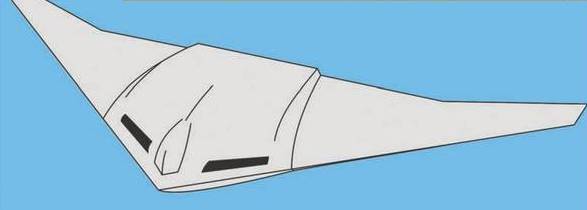I still don't understand why the 6 generation fighter and PAK-DP being hypersonic is normal, an Hypersonic bomber is an heresy.
Well I think the fundamental issue is what value is there in a hypersonic vehicle.
Now when you break it down it makes rather more sense to have the attacking weapon being hypersonic.... Zircon is being tested now and further developments are on the way... there is a current penalty in range... the Zircon is described as being capable of reaching targets beyond 1,000km from a ground launch at mach 9 or 10, which means from an air launch we are probably talking about 1,500km to perhaps as much as 2,000km.
A hypersonic missile is relatively small and affordable and achievable and you really carry it rather more often than you use it so in terms of cost they are not that much different from a similar size and weight subsonic stealthy missile that goes 5,000km.
the compromises to make a fighter or bomber hypersonic would be extreme limiting fuel capacity and internal volume for weapons... most of obviously for the bomber.... essentially the bomber would become a bomber with internal room for bombs only.
You are burning fuel at enormous rates and not just standard fuel... this will be more expensive high energy fuel so operational costs and ownership costs will be enormous... operating the Hustler was expensive... operating the SR-71 was not continuously sustainable for the Americans.... it was retired several times because it cost too much... they brought it back because there was nothing else they had like it, but a strategic bomber fleet would have bankrupted them.
From a conceptual angle it is also a problem... a subsonic or just supersonic bomber is still going to take 6-12 hours to get to launch position and the missiles they launch will take just as long again to reach targets with subsonic 5K km missiles, so the air space they are penetrating is going to have already been devastated by ICBM and SLBMs... the air defence network waiting for these hypersonic bombers is going to be relatively weak anyway... so why spend all this money?
During peace time these bombers can be used for conventional missions but again... it is vastly cheaper to have a subsonic relatively semi stealthy aircraft carrying a mix of long range subsonic stealthy and shorter ranged hypersonic weapons than to have a hypersonic bomber... an object the size of a missile could be made to pull gs no bomber sized aircraft could take... a straight and level flying hypersonic bomber is vulnerable to being shot down by S-300 at 2.8km/s let alone S-400 at 4.8km/s, or anything faster.
For Russia the counter to a hypersonic bomber is much easier than a counter to a hypersonic manouvering missile and the US has the same problem... a hypersonic bomber would be expensive and technically difficult to develop and would burn up a lot of resources and would at best result in something expensive to operate in large numbers and still be vulnerable to existing air defences... a hypersonic bomber wont be manouvering very much at all... a missile on the other hand can take enormous g force.
Remember g force increases with speed.... if you are in your car in an empty parking lot and in first gear at idle revs you can turn very tight circles easily with a fraction of 1 g in turning force (you will still have one g holding you down in your seat of course). Accelerate to 50km/h and turn the wheel a little and you can feel your body trying to continue straight resisting the turn.... that is g force... flying at 3km/s and you want to turn 10 degrees to the left you might pull 20gs...
G induced blackouts only started happening as aircraft got faster... a 300km/h bi plane can't actually pull enormous gs because they can't go fast enough or turn fast enough... the faster the vehicle moves the more gs you pull for the same rate of turn... current bomber types can't handle more than 3-5gs at most... just like civilian airliners can't either.
If you make your hypersonic bomber strong enough to take enormous gs then you have to make it unmanned... so it might as well be an SLBM or ICBM or IRBM.
Really a fighter does not benefit from being hypersonic any more than a bomber does... fighters don't fly at mach 2 now even though many are capable of it because it takes too long flying straight and level and in full AB burns too much fuel and greatly reduces its flight range and endurance.
The only aircraft that benefit from high speed are dedicated interceptors like the MiG-31 or MiG-41... and that is because the faster they move the further away from what they are defending is where they meet and engage their targets... if they can reach them before they launch their weapons then you have 20 B2s and 100 B-52s to deal with instead of 20 B-2s and 100 B-52s and about 3,000 cruise missiles (assuming about 24 per aircraft).
Of course the interceptors don't have to shoot down everything but if they can kill some of the cruise missiles while they are still on their launch platforms it makes it easier for the next layers of the defence.
An aspect is that stealth wont last forever, so speed is obviously a good alternative... as shown with Russian anti ship missiles, but it has taken until the current generation to come down to usable sizes and weights for widespread use... and the problems of trying to kill large objects like aircraft carriers means a bit of kinetic energy is also a bonus for sinking ships during conventional conflicts...
But PAK-DA is subsonic and with a longer range and it will stay in the air much more time cheaply. Expect their weapons bay will be more than 12 mt long, and I hope they have more payload than what is being told.
Well exactly... they have the Blackjack for speed if needed and lets face it... it will be a rather difficult target for subsonic F-35s to intercept anyway... with further improved engine technology a supercruising Blackjack could be on the cards making it a much more formidable threat... but its main threat will be cruise missiles with a mix of subsonic super long range weapons that could be made stealthy to make them harder to detect easily, and hypersonic weapons that you can probably see from a long way away but can't reach...
Low cost operations for the PAK DA means it can be produced in useful numbers and actually used... an MPA version flying around the place showing the flag and embarrassing British F-35s that can't keep up with it when they fly nearby... with thrust vectoring engines you could make it a transonic aircraft that super cruises at certain weights and altitudes...
Maybe Russia can redirect where the huge US defense budget goes, if they achieve the US spending more on protecting Continental United States, and less trying to encircle Russia would be a positive move.
Not really worth trying to influence them... eventually they will realise they can't keep spending money they don't have... well hopefully they realise it before their allies and customers do and they stop accepting US dollars in payment for things... it could get quite nasty because the US is used to swinging its power around the place.
It is known that the PAK DA is designed using the flying wing scheme. The machine will feature technologies and materials that reduce its radar visibility (stealth technology). The plane will be subsonic, and will be able to carry current and future cruise missiles, precision bombs and hypersonic weapons, it will be provided with the newest communications and jamming equipment.
That is what I like about the Russians... it might sound counter intuitive to want a stealth aircraft to have jamming equipment, but when the stealth is not working a plan B is always a good thing.
My understanding of it is that the purpose of strategic bombers (or missile-ers) comes into play during times of substantially elevated tensions between nuclear powers. During such a period, each side may worry that tensions will reach a point where the other may decide to attempt a debilitating first strike. Ground-based silos may be perceived as especially vulnerable to a coordinated surprise attack because they're immobile.
Agreed.
So, once tensions rise to a certain point, the bombers are sent up and stay there in their holding patters for as long as possible until, hopefully, negotiation can bring tensions back down to an acceptable level. Until then, bombers aloft signals a raised posture to adversaries, the perceived threat of a guaranteed retaliatory strike is enhanced, and that helps cooler heads prevail in said negotiations.
Agreed but would also add that a range of other forces are also mobilised too and various other changes and moves are made too that indicate heightened tensions... an example for Russia might be that the truck mobile ICBMs leave their sheds and deploy to the surrounding territory and SSBNs leave their piers... as do other vessels to avoid them getting caught in port...
So, forgoing bombers and just building more ICBMs instead would eliminate that flexibility, no?
Strategic aircraft have serious value... even during peace time as shown in Syria... but a hypersonic air fleet would be too expensive in terms of operational costs to justify. For much of the 1990s the Blackjacks didn't fly very much because of the amount of fuel they needed and they are only mach 2 planes.
Hypersonic has value if it is manouvering hypersonic that is hard to intercept. Put people on board the platform then you limit the platform to 3-4gs at best most of the time and at such speeds even a slight change in flight path will be a high g turn... any weapon intercepting such a target should be able to out turn and being smaller and lighter should be able to move faster too... so it is all bad for the hypersonic bomber. A hypersonic missile on the other hand has all the benefits and none of the drawbacks... they wont burn millions of litres of fuel each day... they only use fuel when they are actually launched and they use it very efficiently... considering the amount of damage they will be doing.




 PapaDragon
PapaDragon
